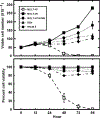Correlation between asparaginase sensitivity and asparagine synthetase protein content, but not mRNA, in acute lymphoblastic leukemia cell lines
- PMID: 17514734
- PMCID: PMC8441542
- DOI: 10.1002/pbc.21213
Correlation between asparaginase sensitivity and asparagine synthetase protein content, but not mRNA, in acute lymphoblastic leukemia cell lines
Abstract
Background: Asparaginase (ASNase) is an essential component of most treatment protocols for childhood acute lymphoblastic leukemia (ALL). Although increased asparagine synthetase (ASNS) expression may contribute to ASNase resistance, there is conflicting data from patient samples with regard to correlation between ASNS mRNA content and ASNase sensitivity.
Procedure: Both T-cell and B-cell derived ALL cell lines were treated with ASNase and then monitored for cell proliferation, cell death, and ASNS mRNA and protein expression.
Results: Despite elevated ASNS mRNA following ASNase treatment, different ALL cell lines varied widely in translation to ASNS protein. Although ASNS mRNA levels did not consistently reflect ASNase sensitivity, there was an inverse correlation between ASNS protein and ASNase-induced cell death. Expression of ASNS in an ASNase-sensitive cell line resulted in enhanced ASNase resistance, and conversely, siRNA-mediated inhibition of ASNS expression promoted increased drug sensitivity.
Conclusions: These observations provide an explanation for the ASNase sensitivity of ALL cells and demonstrate the importance of measuring ASNS protein rather than mRNA in predicting ASNase responsiveness.
(c) 2007 Wiley-Liss, Inc.
Figures




Similar articles
-
Glutaminase Activity of L-Asparaginase Contributes to Durable Preclinical Activity against Acute Lymphoblastic Leukemia.Mol Cancer Ther. 2019 Sep;18(9):1587-1592. doi: 10.1158/1535-7163.MCT-18-1329. Epub 2019 Jun 17. Mol Cancer Ther. 2019. PMID: 31209181 Free PMC article.
-
Low expression of asparagine synthetase in lymphoid blasts precludes its role in sensitivity to L-asparaginase.Exp Hematol. 2012 Aug;40(8):657-65. doi: 10.1016/j.exphem.2012.04.005. Epub 2012 Apr 25. Exp Hematol. 2012. PMID: 22542578
-
Polymorphisms of asparaginase pathway and asparaginase-related complications in children with acute lymphoblastic leukemia.Clin Cancer Res. 2015 Jan 15;21(2):329-34. doi: 10.1158/1078-0432.CCR-14-0508. Epub 2014 Jun 6. Clin Cancer Res. 2015. PMID: 24907114 Free PMC article.
-
Asparaginase pharmacology: challenges still to be faced.Cancer Chemother Pharmacol. 2017 Mar;79(3):439-450. doi: 10.1007/s00280-016-3236-y. Epub 2017 Feb 14. Cancer Chemother Pharmacol. 2017. PMID: 28197753 Review.
-
Asparagine synthetase chemotherapy.Annu Rev Biochem. 2006;75:629-54. doi: 10.1146/annurev.biochem.75.103004.142520. Annu Rev Biochem. 2006. PMID: 16756505 Free PMC article. Review.
Cited by
-
The transcription factor network associated with the amino acid response in mammalian cells.Adv Nutr. 2012 May 1;3(3):295-306. doi: 10.3945/an.112.001891. Adv Nutr. 2012. PMID: 22585903 Free PMC article. Review.
-
The combination of calreticulin-targeting L-ASNase and anti-PD-L1 antibody modulates the tumor immune microenvironment to synergistically enhance the antitumor efficacy of radiotherapy.Theranostics. 2024 Jan 20;14(3):1195-1211. doi: 10.7150/thno.90376. eCollection 2024. Theranostics. 2024. PMID: 38323311 Free PMC article.
-
L-asparaginase induces IP3R-mediated ER Ca2+ release by targeting µ-OR1 and PAR2 and kills acute lymphoblastic leukemia cells.Cell Death Discov. 2024 Aug 15;10(1):366. doi: 10.1038/s41420-024-02142-9. Cell Death Discov. 2024. PMID: 39147734 Free PMC article.
-
Advancing Cancer Treatment by Targeting Glutamine Metabolism-A Roadmap.Cancers (Basel). 2022 Jan 22;14(3):553. doi: 10.3390/cancers14030553. Cancers (Basel). 2022. PMID: 35158820 Free PMC article. Review.
-
Metabolism of asparagine in the physiological state and cancer.Cell Commun Signal. 2024 Mar 6;22(1):163. doi: 10.1186/s12964-024-01540-x. Cell Commun Signal. 2024. PMID: 38448969 Free PMC article. Review.
References
-
- Sallan SE, Hitchcock-Bryan S, Gelber R, et al.Influence of intensive asparaginase in the treatment of childhood non-T-cell acute lymphoblastic leukemia. Cancer Res 1983;43:5601–5607. - PubMed
-
- Amylon MD, Shuster J, Pullen J, et al.Intensive high-dose asparaginase consolidation improves survival for pediatric patients with T cell acute lymphoblastic leukemia and advanced stage lymphoblastic lymphoma: a Pediatric Oncology Group study. Leukemia 1999;13:335–342. - PubMed
-
- Cooney DA, Capizzi RL, Handshumacher RE. Evaluation of L-asparagine metabolism in animals and man. Cancer Res1970;30: 929–935. - PubMed
-
- Chen H, Pan YX, Dudenhausen EE, et al.Amino acid deprivation induces the transcription rate of the human asparagine synthetase gene through a timed program of expression and promoter binding of nutrient-responsive bZIP transcription factors as well as localized histone acetylation. J Biol Chem 2004;279:50829–50839. - PubMed
Publication types
MeSH terms
Substances
Grants and funding
LinkOut - more resources
Full Text Sources
Other Literature Sources

